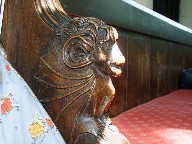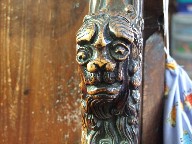| |
|
 |
|
Sudbury is a good town, with
plenty of interesting early survivals in
its medieval street plan. Together with
its extensive suburb of Great Cornard,
Sudbury forms Suffolk's seventh largest
town, and it is surrounded on two sides
by the county border between Suffolk and
Essex. Early modern Sudbury was
prosperous enough to be divided up into
three parishes. These were All Saints, St
Gregory and St Peter, the last of which
had been carved out of St Gregory's
parish. St Peter and St Gregory were
later recombined, and St Peter's church
on the market place has fallen into
disuse, but All Saints remains as a
separate parish, just as in the 15th
Century. The grand tower is
best seen when approaching the town from
the south, when it appears above the
neighbouring medieval inn. Ballingdon,
that part of the parish south of the
Stour, was in Essex until the 20th
Century, a curious anomaly. The main road
rushes you past, and so unless you turn
off to take the winding lane to the south
of the church that might well be your
only sight of All Saints.
|
If
you do investigate, you will find that the
medieval street pattern severely curtails the
churchyard, with the east end of the chancel hard
against the road. It is as if it has been
shoehorned onto the site. There are surviving
graves to south and north, with a fine rectory
overlooking the north side of the churchyard. The
large mausoleum in the middle is that to the
Gainsborough family, merchants of this town,
whose most famous member was the artist, Thomas.
His statue stands on Market Hill, outside St Peter; but he
himself is buried in London.
This
is a handsome exterior, and alone of Sudbury's
churches had a spire, which came down in the
early 19th century. The church was completely
rebuilt in the 15th century, and the tower has
similarities with that of St Gregory. Seen from
the meadows to the west of the town, All Saints
is the grander. There was once a porch on either
side, but both have gone. Beside the south door,
there is a very handsome holy water stoup.
Just
as St Gregory is in the High Church tradition, so
All Saints complements it by being evangelical in
character. Perhaps because of this the church is
kept locked, but there are keyholders listed.
Unfortunately, I forgot to ask which door the key
was to, which led to the slightly absurd
experience of going from the south side to the
north side several times trying to get a door
open. I must admit that it took me some time to
discover that the key fitted an almost hidden
keyhole in the south door.
Even
on a sunny day, this church is rather gloomier
than its neighbour St Gregory. Some home made
banners lining the pillars of the arcades cheered it
up a bit. Above, the arches are decorated with
shields and paterae, and the clerestory lights a
fine 15th century roof. The woodwork is the most
interesting feature of the nave. The
pre-Reformation woodwork of the pulpit supposedly
survived in such good condition by being boarded
over for many centuries. The IHS symbol is a
later addition by that great Victorian craftsman
Henry Ringham. When I last came this way in 2001
there was a stunning lectern in the form of a
standing angel, forming the parish war memorial,
but this no longer appears to be in situ. I was
pleased to find that the old benches were still
here, as churches of evangelical character have
exhibited an enthusiasm for replacing them with
modern chairs in recent years. There are bell
carvings on the most westerly row, suggesting
that they were to be reserved for the
bellringers. I suppose that it would be a very
unusual bellringer today who attended services as
well.
| There are a couple of more
ancient survivals. Firstly, the screen
into the south aisle chapel is original,
and partitioned off the 15th century
Felton chantry.
Secondly, dating from 1622, there is an
unusual mural in the vestry, to the north
of the chancel. It was done when this was
the north aisle chapel, to show the
family tree of Edens. Each conjunction is
depicted by heraldic shields, with
roundels for names beneath. Mortlock
thought that the writing had faded, but I
don't think they were ever filled in.
Look closely, and you'll see the marks
made by the compass point of the 17th
century mason who did the work. Outside,
you'll find one of these compasses
depicted among other masonic tools on a
grave stone, to the north of the tower. Much
destruction occured in this church in the
1660s. It had been (like so many) used
for purposes other than worship during
the Puritan Commonwealth, and continued
in use as a prison after the Restoration.
That so much has survived is remarkable,
under the circumstances.
|
|
 |
|
|
|

